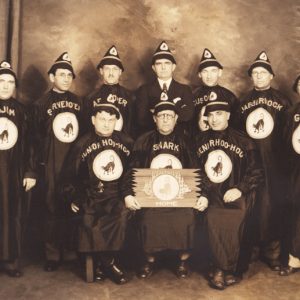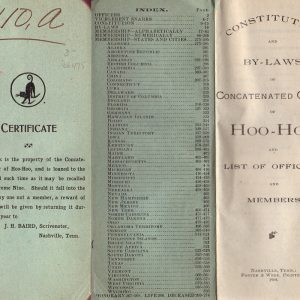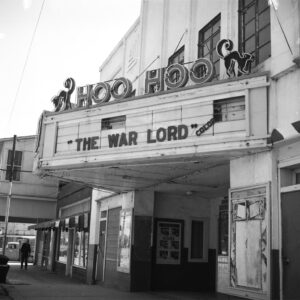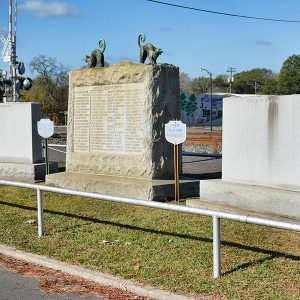calsfoundation@cals.org
Concatenated Order of Hoo-Hoo
Founded in 1892, the Concatenated Order of Hoo-Hoo is a fraternal organization of lumbermen and those in trades related to the lumber industry. Hoo-Hoo is the oldest industrial fraternal organization in the United States. At the height of the organization’s popularity, membership totaled more than 13,000. The headquarters of the order and its museum are located in Gurdon (Clark County), the town where Hoo-Hoo originated. The order had more than 3,500 members in 2004, but membership had fallen to 2,500 by 2014.
The order was established on January 21, 1892, when six men saw a need for an organization to promote unity and fellowship among lumbermen and to combat a possible split brought on by the lumbermen’s broad range of pursuits. These six men—Bolling Arthur Johnson, a journalist of Timberman in Chicago; George Washington Schwarz of Vandalia Railroad in St. Louis; William Starr Mitchell of the Arkansas Democrat; William Eddy Barns of the St. Louis Lumberman; George Kimball Smith, secretary of Southern Lumber Manufacturers’ Association; and Ludolph Adalbert Strauss of the Malvern Lumber Company—began discussing the idea of an organization for lumbermen.
In Hotel Hall in Gurdon, the men set up the basic tenets of the order. Hoo-Hoo was to be an organization comprising men with high ideals, and the order’s motto became “Health, Happiness, and Long Life.” The group (led by Johnson) decided that the board of directors would be called the “Supreme Nine.” The names of the directors were: Snark of the Universe (president), Bojum (chaplain), Scrivenoter (secretary), Gurdon (sergeant-at-arms), Senior Hoo-Hoo, Junior Hoo-Hoo, Custocacian, Arcanoper, and Bandersnatch (later changed to Jabberwock). Some of these names were derived from Lewis Carroll’s Hunting of the Snark, which one of the founders had recently read. The name “Hoo-Hoo” also had a unique origin. In Kansas City, about a month before the founding of the order, Johnson had used the term “hoo-hoo” to refer to an unusual tuft of hair on the head of Charles McCarer. McCarer became the first Snark of the Universe and was given membership number one.
Consistent with their unconventionality, the group chose as its mascot a black cat with its tail curved into the number nine. Originally, membership in Hoo-Hoo was to be limited to 9,999 members. As the order increased in popularity, this number was changed to 99,999. Meetings were held on the ninth day of the ninth month at nine minutes after the ninth hour. Annual dues were $9.99, and the initiation fee was $0.99.
After its humble beginnings in Gurdon, the Concatenated Order of Hoo-Hoo grew tremendously. The first club established outside the United States was founded in Canada in 1924, and other groups sprouted up in places as far away as Australia. Though the Hoo-Hoo experienced a slump from 1929 to 1938, when membership dropped to around 700, the order recovered, and membership began to rise again.
Two U.S. presidents have had membership in Hoo-Hoo. Theodore Roosevelt was given the reserved membership number 999 for his work promoting the importance of forests. Warren G. Harding, membership number 14,945, was “concatenated” in 1905.
A monument commemorating the Hoo-Hoos is located on North First Street in Gurdon. Several elements make up the present-day monument. The base of the monument is an ashlar-faced barre granite stone measuring 116 inches high, 107 inches wide and forty-four inches deep. The second element of the monument, and that which makes it of historic significance, is a bronze plaque sculpted by noted artist George J. Zolnay. This plaque was completed in 1909, at which time it was affixed to a building, then occupying the site of the Hotel Hall. When this building was demolished in 1927, the Zolnay plaque was moved to its present location, affixed to the granite base, and rededicated.
Zolnay sculpted the plaque with Egyptian Revival reliefs and engravings. The pediment is illustrated with the image of a two-headed bird.
The second horizontal level of the monument contains a relief of the Hotel Hall. The third level contains an inscription recounting the founding of Hoo-Hoo. The names of all Hoo-Hoo presidents are engraved on the opposite side of the base and on two small granite monuments at each side. The monument was added to the National Register of Historic Places on September 2, 1999.
In 1981, Hoo-Hoo moved its international headquarters from Boston (where it had been since 1970) to Gurdon and dedicated the International Hoo-Hoo Headquarters and Museum in April of that same year.
For additional information:
“1892–1992: A Century of Fraternalism.” Special issue. Log & Tally. May 1992.
Hoo-Hoo International. http://www.hoo-hoo.org/ (accessed September 1, 2022).
Newberry, Farrar. “The Concatenated Order of Hoo-Hoo.” Arkansas Historical Quarterly 20 (Spring/Winter 1963): 301–310.
Syler, Allen B., et al., eds. Through the Eyes of Farrar Newberry. Arkadelphia, AR: Clark County Historical Association, 2002.
Rachel Bridges
Ouachita Baptist University
 Concatenated Order of Hoo-Hoo
Concatenated Order of Hoo-Hoo  Concatenated Order of Hoo-Hoo
Concatenated Order of Hoo-Hoo  Concatenated Order of Hoo-Hoo Constitution
Concatenated Order of Hoo-Hoo Constitution  Concatenated Order of Hoo-Hoo Membership Card
Concatenated Order of Hoo-Hoo Membership Card  Hoo Hoo Theater
Hoo Hoo Theater  Hoo-Hoo Monument
Hoo-Hoo Monument  Hoo-Hoo Museum
Hoo-Hoo Museum  William Starr Mitchell Sr.
William Starr Mitchell Sr. 




I am a 1954 graduate of what was then Ouachita College. On an evening in the dorm, several guys gathered in my room. We got to talking about dares. One guy said: “I dare someone to walk to Gurdon tonight. I’ll give ten dollars to a taker.” I needed ten dollars real bad so I told them I would do it. To assure him of no trickery (I didn’t have a car), I was told to go to the train station and copy words written on the Hoo-Hoo monument. I hardly knew where Gurdon was. There was no I-30. I sure had never heard of the Hoo-Hoo monument. I wasn’t sure it existed. I caught the 6:00 bus to Arkadelphia and missed all my morning classes, but I got my ten dollars!